Entry Database : PDB / ID : 3u2pTitle Crystal structure of N-terminal three extracellular domains of ErbB4/Her4 Receptor tyrosine-protein kinase erbB-4 Keywords / / / Function / homology Function Domain/homology Component
/ / / / / / / / / / / / / / / / / / / / / / / / / / / / / / / / / / / / / / / / / / / / / / / / / / / / / / / / / / / / / / / / / / / / / / / / / / / / / / / / / / / / / / / / / / / / / / / / / / / / / / / / / / / / / / / / / / / / / / / / / / / / / / / / / / / / Biological species Homo sapiens (human)Method / / Resolution : 2.57 Å Authors Liu, P. / Bouyain, S. / Elgenbrot, C. / Leahy, D.J. Journal : Protein Sci. / Year : 2012Title : The ErbB4 extracellular region retains a tethered-like conformation in the absence of the tether.Authors : Liu, P. / Bouyain, S. / Eigenbrot, C. / Leahy, D.J. History Deposition Oct 4, 2011 Deposition site / Processing site Revision 1.0 Nov 9, 2011 Provider / Type Revision 1.1 Oct 3, 2012 Group Revision 1.2 Jul 29, 2020 Group / Derived calculations / Structure summaryCategory chem_comp / entity ... chem_comp / entity / pdbx_chem_comp_identifier / pdbx_entity_nonpoly / struct_conn / struct_site / struct_site_gen Item _chem_comp.name / _chem_comp.type ... _chem_comp.name / _chem_comp.type / _entity.pdbx_description / _pdbx_entity_nonpoly.name / _struct_conn.pdbx_dist_value / _struct_conn.pdbx_leaving_atom_flag / _struct_conn.pdbx_role / _struct_conn.ptnr1_auth_seq_id / _struct_conn.ptnr1_label_seq_id / _struct_conn.ptnr2_auth_seq_id / _struct_conn.ptnr2_label_asym_id Description / Provider / Type Revision 1.3 Sep 13, 2023 Group Data collection / Database references ... Data collection / Database references / Refinement description / Structure summary Category chem_comp / chem_comp_atom ... chem_comp / chem_comp_atom / chem_comp_bond / database_2 / pdbx_initial_refinement_model Item / _database_2.pdbx_DOI / _database_2.pdbx_database_accession
Show all Show less
 Yorodumi
Yorodumi Open data
Open data Basic information
Basic information Components
Components Keywords
Keywords Transferase /
Transferase /  Signaling protein /
Signaling protein /  Cell surface receptor /
Cell surface receptor /  Signaling
Signaling Function and homology information
Function and homology information central nervous system morphogenesis / neuregulin receptor activity / cardiac muscle tissue regeneration / ERBB2-ERBB4 signaling pathway / mitochondrial fragmentation involved in apoptotic process /
central nervous system morphogenesis / neuregulin receptor activity / cardiac muscle tissue regeneration / ERBB2-ERBB4 signaling pathway / mitochondrial fragmentation involved in apoptotic process /  GABA receptor binding ...establishment of planar polarity involved in nephron morphogenesis / ERBB4 signaling pathway / ERBB4-ERBB4 signaling pathway / olfactory bulb interneuron differentiation /
GABA receptor binding ...establishment of planar polarity involved in nephron morphogenesis / ERBB4 signaling pathway / ERBB4-ERBB4 signaling pathway / olfactory bulb interneuron differentiation /  central nervous system morphogenesis / neuregulin receptor activity / cardiac muscle tissue regeneration / ERBB2-ERBB4 signaling pathway / mitochondrial fragmentation involved in apoptotic process /
central nervous system morphogenesis / neuregulin receptor activity / cardiac muscle tissue regeneration / ERBB2-ERBB4 signaling pathway / mitochondrial fragmentation involved in apoptotic process /  GABA receptor binding / PI3K events in ERBB4 signaling / mammary gland epithelial cell differentiation / embryonic pattern specification / positive regulation of protein localization to cell surface / neurotransmitter receptor localization to postsynaptic specialization membrane /
GABA receptor binding / PI3K events in ERBB4 signaling / mammary gland epithelial cell differentiation / embryonic pattern specification / positive regulation of protein localization to cell surface / neurotransmitter receptor localization to postsynaptic specialization membrane /  neural crest cell migration /
neural crest cell migration /  epidermal growth factor receptor activity /
epidermal growth factor receptor activity /  epidermal growth factor receptor binding / ERBB2 Activates PTK6 Signaling / Signaling by ERBB4 / ERBB2 Regulates Cell Motility / cell surface receptor signaling pathway via JAK-STAT /
epidermal growth factor receptor binding / ERBB2 Activates PTK6 Signaling / Signaling by ERBB4 / ERBB2 Regulates Cell Motility / cell surface receptor signaling pathway via JAK-STAT /  Long-term potentiation / PI3K events in ERBB2 signaling / SHC1 events in ERBB4 signaling / GABA-ergic synapse / mammary gland alveolus development /
Long-term potentiation / PI3K events in ERBB2 signaling / SHC1 events in ERBB4 signaling / GABA-ergic synapse / mammary gland alveolus development /  cell fate commitment / Nuclear signaling by ERBB4 / positive regulation of tyrosine phosphorylation of STAT protein / positive regulation of cardiac muscle cell proliferation /
cell fate commitment / Nuclear signaling by ERBB4 / positive regulation of tyrosine phosphorylation of STAT protein / positive regulation of cardiac muscle cell proliferation /  regulation of cell migration / Signaling by ERBB2 / cellular response to epidermal growth factor stimulus /
regulation of cell migration / Signaling by ERBB2 / cellular response to epidermal growth factor stimulus /  synapse assembly / Downregulation of ERBB4 signaling /
synapse assembly / Downregulation of ERBB4 signaling /  lactation / GRB2 events in ERBB2 signaling /
lactation / GRB2 events in ERBB2 signaling /  transmembrane receptor protein tyrosine kinase activity / SHC1 events in ERBB2 signaling /
transmembrane receptor protein tyrosine kinase activity / SHC1 events in ERBB2 signaling /  neurogenesis / basal plasma membrane /
neurogenesis / basal plasma membrane /  cell surface receptor protein tyrosine kinase signaling pathway / postsynaptic density membrane / Signaling by ERBB2 TMD/JMD mutants / positive regulation of receptor signaling pathway via JAK-STAT /
cell surface receptor protein tyrosine kinase signaling pathway / postsynaptic density membrane / Signaling by ERBB2 TMD/JMD mutants / positive regulation of receptor signaling pathway via JAK-STAT /  neuromuscular junction / Signaling by ERBB2 KD Mutants /
neuromuscular junction / Signaling by ERBB2 KD Mutants /  receptor protein-tyrosine kinase / Downregulation of ERBB2 signaling / peptidyl-tyrosine phosphorylation / Constitutive Signaling by Aberrant PI3K in Cancer /
receptor protein-tyrosine kinase / Downregulation of ERBB2 signaling / peptidyl-tyrosine phosphorylation / Constitutive Signaling by Aberrant PI3K in Cancer /  cell migration / PIP3 activates AKT signaling /
cell migration / PIP3 activates AKT signaling /  presynaptic membrane /
presynaptic membrane /  nervous system development /
nervous system development /  heart development / PI5P, PP2A and IER3 Regulate PI3K/AKT Signaling / RAF/MAP kinase cascade / basolateral plasma membrane /
heart development / PI5P, PP2A and IER3 Regulate PI3K/AKT Signaling / RAF/MAP kinase cascade / basolateral plasma membrane /  postsynaptic membrane /
postsynaptic membrane /  protein tyrosine kinase activity / Estrogen-dependent gene expression / protein autophosphorylation / positive regulation of phosphatidylinositol 3-kinase/protein kinase B signal transduction / positive regulation of ERK1 and ERK2 cascade /
protein tyrosine kinase activity / Estrogen-dependent gene expression / protein autophosphorylation / positive regulation of phosphatidylinositol 3-kinase/protein kinase B signal transduction / positive regulation of ERK1 and ERK2 cascade /  receptor complex / transcription cis-regulatory region binding /
receptor complex / transcription cis-regulatory region binding /  mitochondrial matrix / positive regulation of protein phosphorylation / negative regulation of cell population proliferation / glutamatergic synapse / positive regulation of cell population proliferation / negative regulation of apoptotic process / positive regulation of DNA-templated transcription /
mitochondrial matrix / positive regulation of protein phosphorylation / negative regulation of cell population proliferation / glutamatergic synapse / positive regulation of cell population proliferation / negative regulation of apoptotic process / positive regulation of DNA-templated transcription /  signal transduction / protein homodimerization activity /
signal transduction / protein homodimerization activity /  mitochondrion / extracellular region /
mitochondrion / extracellular region /  nucleoplasm /
nucleoplasm /  ATP binding /
ATP binding /  nucleus /
nucleus /  plasma membrane /
plasma membrane /  cytosol
cytosol
 Homo sapiens (human)
Homo sapiens (human) X-RAY DIFFRACTION /
X-RAY DIFFRACTION /  MOLECULAR REPLACEMENT / Resolution: 2.57 Å
MOLECULAR REPLACEMENT / Resolution: 2.57 Å  Authors
Authors Citation
Citation Journal: Protein Sci. / Year: 2012
Journal: Protein Sci. / Year: 2012 Structure visualization
Structure visualization Molmil
Molmil Jmol/JSmol
Jmol/JSmol Downloads & links
Downloads & links Download
Download 3u2p.cif.gz
3u2p.cif.gz PDBx/mmCIF format
PDBx/mmCIF format pdb3u2p.ent.gz
pdb3u2p.ent.gz PDB format
PDB format 3u2p.json.gz
3u2p.json.gz PDBx/mmJSON format
PDBx/mmJSON format Other downloads
Other downloads https://data.pdbj.org/pub/pdb/validation_reports/u2/3u2p
https://data.pdbj.org/pub/pdb/validation_reports/u2/3u2p ftp://data.pdbj.org/pub/pdb/validation_reports/u2/3u2p
ftp://data.pdbj.org/pub/pdb/validation_reports/u2/3u2p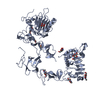
 Links
Links Assembly
Assembly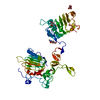
 Components
Components
 Homo sapiens (human) / Gene: ERBB4, HER4 / Production host:
Homo sapiens (human) / Gene: ERBB4, HER4 / Production host: 
 Cricetulus griseus (Chinese hamster) / Strain (production host): Lec1
Cricetulus griseus (Chinese hamster) / Strain (production host): Lec1 receptor protein-tyrosine kinase
receptor protein-tyrosine kinase N-Acetylglucosamine
N-Acetylglucosamine Water
Water X-RAY DIFFRACTION / Number of used crystals: 1
X-RAY DIFFRACTION / Number of used crystals: 1  Sample preparation
Sample preparation
 ROTATING ANODE / Type: RIGAKU FR-E+ SUPERBRIGHT / Wavelength: 1.5418 Å
ROTATING ANODE / Type: RIGAKU FR-E+ SUPERBRIGHT / Wavelength: 1.5418 Å : 1.5418 Å / Relative weight: 1
: 1.5418 Å / Relative weight: 1  Processing
Processing :
:  MOLECULAR REPLACEMENT
MOLECULAR REPLACEMENT Movie
Movie Controller
Controller


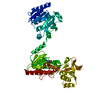
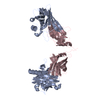



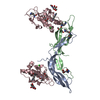

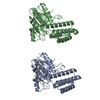
 PDBj
PDBj














